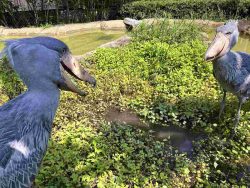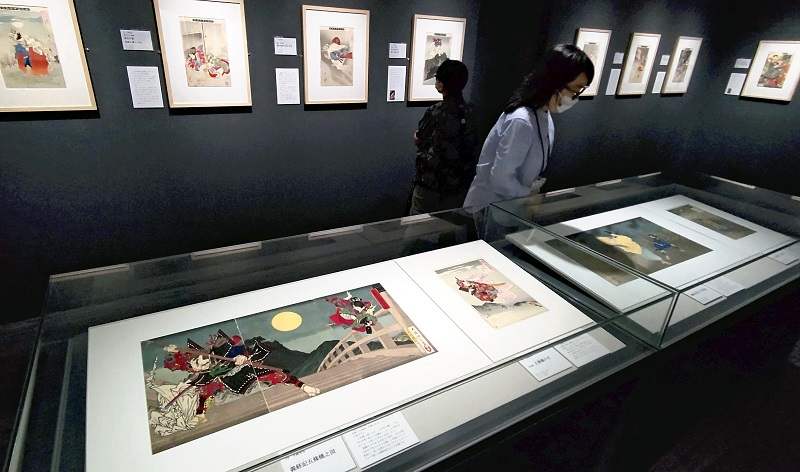
Ukiyo-e works, including “Yoshitsune-ki Gojohashi no Zu” and other dynamically drawn works, are exhibited in the Kawasaki Ukiyo-e Gallery.
10:34 JST, July 24, 2022
The Kawasaki Ukiyo-e Gallery opened in 2019 in Kawasaki, a city that was one of the 53 Stations of the Tokaido highway, depicted in many ukiyo-e woodblock prints.
The gallery is in a building directly connected to JR Kawasaki Station, so visitors can take a trip to see ukiyo-e works without worrying about getting wet when it rains.
The gallery stores more than 5,000 items from a collection assembled over many years by Fumio Saito, a former House of Councillors member.
The works are mainly by Katsushika Hokusai, Utagawa Hiroshige and artists with close ties to Kanagawa Prefecture.
A public interest organization, for which Saito serves as the representative, donated the works to the Kawasaki city government, and the city government spent about ¥100 million to build the gallery.
The gallery selects from among items in the collection based on changing themes, and replaces exhibited items about once a month.
This year, the gallery has exhibited bijin-ga (pictures of beautiful women) works by Utagawa Kunisada, Kikukawa Eizan and Keisai Eisen, and a series of nishiki-e colored woodblock prints by Utagawa Kuniyoshi, titled “Kisokaido Rokujukyu Tsugi no Uchi” (Sixty-nine stations of the Kiso Road), among others.
It had exhibited the first part of the “Shinkei Sanjurokkaisen” (New forms of thirty-six ghosts) series by Tsukioka Yoshitoshi until July 10.
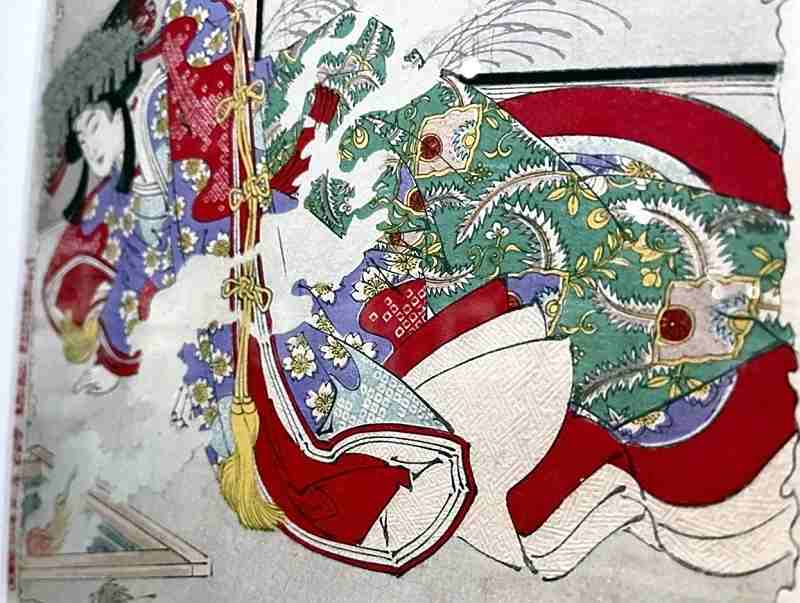
“Seigen no Rei Sakurahime wo Shitau no Zu” in the “Shinkei Sanjurokkaisen” series. The white parts of the kimono are produced by a technique called karazuri that gives the surface a more three-dimensional feel.
Tsukioka Yoshitoshi (1839-1892) studied under Utagawa Kuniyoshi and at age 15 debuted as an ukiyo-e artist. Tsukioka produced a wide variety of works, from samurai portraits and pictures of beautiful women to nishiki-e that depicted contemporary incidents.
He was active from the last years of the Edo period (1603-1867) into the early years of the Meiji era (1868-1912), when ukiyo-e entered a period of decline. He has consequently been dubbed the last ukiyo-e artist.
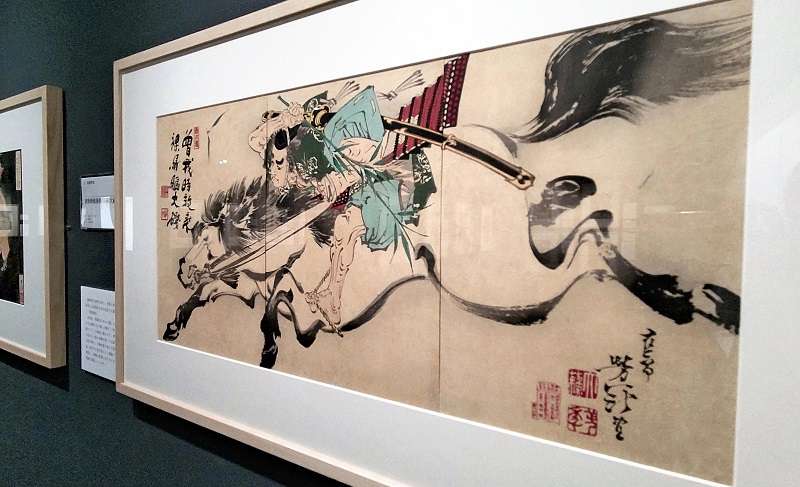
Extremely smooth lines that look unlike a typical woodblock print depict samurai warrior Soga Tokimune riding a horse.
The “Shinkei Sanjurokkaisen” series, Tsukioka’s late-life masterpiece, depicts monsters, ghosts and demons.
One print in the series is titled, “Gamo Sadahide ga Shin Toki Motosada Koshu Inohanayama Mao Nagetaoshi no Zu” (Gamo Sadahide’s servant, Toki Motosada, hurling a demon king to the ground at Mount Inohana). It depicts a scene where the warrior Toki Motosada is challenged to a sumo match by monsters who have taken on the appearance of a Nio Buddhist guardian and the Amida Buddha, and he hurls them to their defeat.
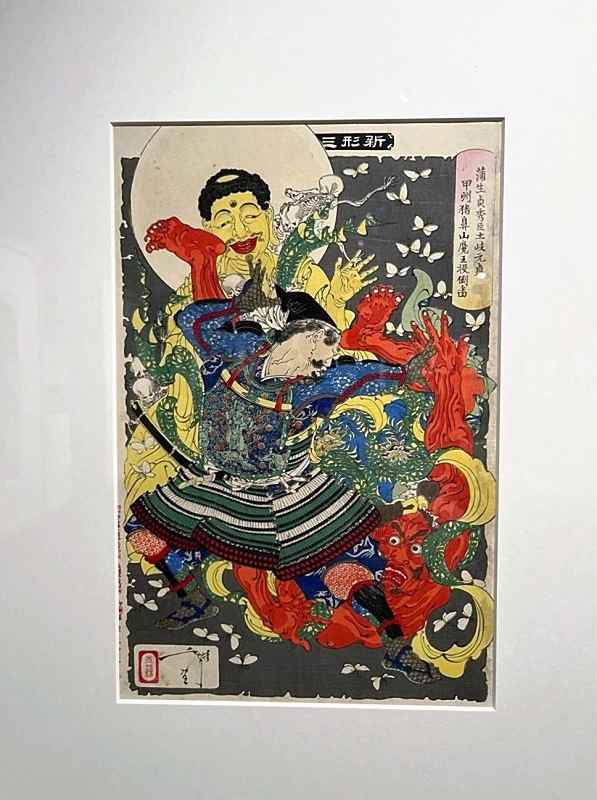
A skeleton and butterflies appear to be on the verge of movement in this work depicting samurai warrior Toki Motosada’s legendary sumo match.
Toki Motosada’s stance bears a striking vigor and the print’s fine details, such as on the brightly colored armor, are a pleasure to look at.
The gallery also exhibited other ukiyo-e series by Tsukioka, such as “Kokoku Nijushi Ko” (Twenty-four paragons of imperial Japan) and “Tsuki Hyakushi” (One hundred aspects of the moon).
On July 16, the second part of the “Shinkei Sanjurokkaisen” exhibition began displaying a fresh selection of works.
The major appeal of the gallery is that visitors are able to see many great works because the gallery replaces exhibited items regularly.
Yukiko Hiruta, a curator at the gallery, said, “I want people to enjoy these masterpieces at their leisure, so that they may find some new point of beauty in these ukiyo-e that were created in the Edo period.”
Kawasaki Ukiyo-e Gallery
The gallery opened in December 2019. It prides itself on its rich collection, which includes ukiyo-e works related to Kanagawa Prefecture. It is a two-minute walk from the north exit of JR Kawasaki Station.
Address: 3F Kawasaki Ekimae Tower RiverK, 12-1 Ekimae-honcho, Kawasaki Ward, Kawasaki
Hours: 11 a.m. to 6:30 p.m. Closed on Mondays (if a public holiday falls on a Monday, then the following day). The gallery is also closed during periods when exhibited items are being changed out.
Admission: ¥500
Related Tags
"Features" POPULAR ARTICLE
-

Sanrio to Open Museum in Yamanashi Pref. Dedicated to Founder, Exhibits Include Hello Kitty, Other Characters
-

Autumn Foliage Surrounds Visitors to Tokyo’s Showa Kinen Park
-

My Daughter No Longer Speaks to Me, But I Want to See Her and My Grandchild
-

Kumamoto: Public Bath Refurbished as Library Where You Can Chat, Take Photos
-

Frozen Vegetables: Demand Rises for Convenient, Tasty Domestic Produce
JN ACCESS RANKING
-

Tokyo Economic Security Forum to Hold Inaugural Meeting Amid Tense Global Environment
-

Keidanren Chairman Yoshinobu Tsutsui Visits Kashiwazaki-Kariwa Nuclear Power Plant; Inspects New Emergency Safety System
-

Imports of Rare Earths from China Facing Delays, May Be Caused by Deterioration of Japan-China Relations
-

University of Tokyo Professor Discusses Japanese Economic Security in Interview Ahead of Forum
-

Japan Pulls out of Vietnam Nuclear Project, Complicating Hanoi’s Power Plans



